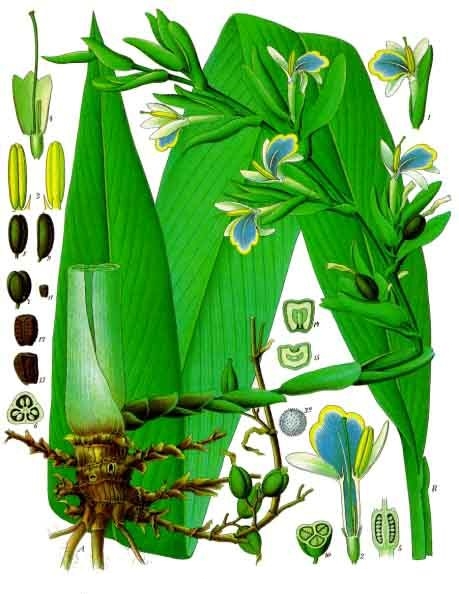- Elettaria
taxobox
name = "Elettaria"
image_caption = True Cardamom ("Elettaria cardamomum")
regnum =Plantae
unranked_divisio =Angiosperms
unranked_classis =Monocots
unranked_ordo =Commelinids
ordo =Zingiberales
familia =Zingiberaceae
genus = "Elettaria"
genus_authority = Maton
species = "E. cardamomum"
binomial = "Elettaria cardamomum"
binomial_authority = (L.) Maton|"Elettaria" is a genus of one or two species of
cardamom s, native to southeasternAsia fromIndia south toSri Lanka and east toMalaysia and westernIndonesia , where it grows in tropicalrainforest s.Some authorities treat the genus as containing only one species "Elettaria cardamomum", while others separate Sri Lankan plants out as a separate species "Elettaria repens" Sonner. Common names include Green Cardamom, True Cardamom, and ("E. repens") Ceylon Cardamom; in Hindi it is Elachi or Elaichi in
malayalam Ellaykka.It is a pungent aromatic
herbaceous perennial plant growing to 2–4 m in height. The leaves are alternate in two ranks, linear-lanceolate, 40-60 cm long, with a long pointed tip. Theflower s are white to lilac or pale violet, produced in a loose spike 30-60 cm long. Thefruit is a three-sided yellow-green pod 1-2 cm long, containing several blackseed s.Uses
The green seed pods of the plant are dried and the seeds inside the pod are used in Indian and other
Asian cuisine s either whole or in a ground form. It is the most widely cultivated species of cardamom; for other types and uses, seecardamom .Ground cardamom is an ingredient in many Indian curries, and is a primary contributor to the flavour of
masala chai . In theMiddle East andIran , cardamom is used to flavourcoffee andtea . In Turkey, it is used to flavor the black Turkish tea (Kakakule in Turkish).As well as in its native range, it is also grown in
Nepal ,Vietnam ,Thailand , andCentral America . In India, the states ofSikkim andKerala are the main producers of cardamom; they rank highest both in cultivated area and in production. It was first imported into Europe c.1200 CE .References
* [http://www.plantnames.unimelb.edu.au/Sorting/Elettaria.html University of Melbourne: Sorting "Elettaria" names]
* [http://www.ars-grin.gov/cgi-bin/npgs/html/splist.pl?4169 Germplasm Resources Information Network: "Elettaria"]
Wikimedia Foundation. 2010.
